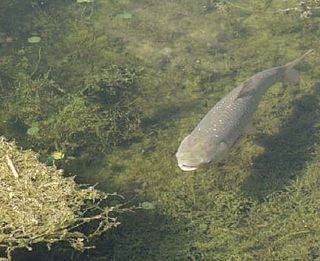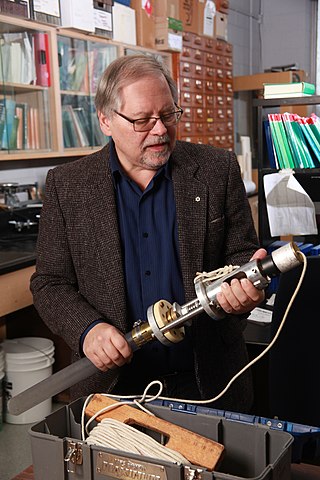Related Research Articles

The University of Windsor is a public research university in Windsor,Ontario,Canada. It is Canada's southernmost university. It has approximately 17,500 students. The university was incorporated by the provincial government in 1962 and has more than 150,000 alumni.

The zebra mussel is a small freshwater mussel. The species originates from the lakes of southern Russia and Ukraine,but has been accidentally introduced to numerous other areas and has become an invasive species in many countries worldwide. Since the 1980s,the species has invaded the Great Lakes,Hudson River,and Lake Travis. The adverse effects of dreissenid mussels on freshwater systems have led to their ranking as one of the world's most invasive aquatic species.[https://doi.org/10.20944/preprints202310.0535.v1,encyclopedia of biological invasions ISBN:9780520264212]

The Natural Sciences and Engineering Research Council of Canada is the major federal agency responsible for funding natural sciences and engineering research in Canada. NSERC directly funds university professors and students as well as Canadian companies to perform research and training. With funding from the Government of Canada,NSERC supports the research of over 41,000 students,trainees and professors at universities and colleges in Canada with an annual budget of CA$1.1 billion in 2015. Its current director is Alejandro Adem.

Several species of heavy-bodied cyprinid fishes are collectively known in the United States as Asian carp. Cyprinids from the Indian subcontinent—for example,catla and mrigal —are not included in this classification and are known collectively as "Indian carp". Asian carp are considered invasive species in the United States. In June,2022,the EPA funded initiative to rebrand Asian Carp as Copi was announced. The new name —Copi —is a part of the Federal and multi-state campaign to reintroduce the carps to the public as a healthy and responsible seafood option in order to decrease its numbers in U.S. waterways.

Science North is an interactive science museum in Greater Sudbury,Ontario,Canada.

The quagga mussel is a species of freshwater mussel,an aquatic bivalve mollusk in the family Dreissenidae. It has an average lifespan of 3 to 5 years.

Paul David Neil Hebert is a Canadian biologist. He is founder and director of the Centre for Biodiversity Genomics at the University of Guelph in Ontario,Canada. He applied the technique invented by Carl Woese and colleagues in the 1980s to arthropods and called it DNA barcoding.

The Faculty of Law is a faculty of the University of Windsor in Windsor,Ontario,Canada. The first class of students matriculated in 1968,and the current building was opened in 1970. The Faculty has grown immensely over the past 50 years,increasing its national profile through its innovations in research and from thousands of alumni across Canada and the world. The 2017 endowment to the Faculty of Law was $10.2 million. The Faculty is also the current academic host institution of the Canadian Bar Review (CBR),the most frequently cited journal by the Supreme Court of Canada.
David William Schindler,,was an American/Canadian limnologist. He held the Killam Memorial Chair and was Professor of Ecology in the Department of Biological Sciences at the University of Alberta in Edmonton,Alberta. He was notable for "innovative large-scale experiments" on whole lakes at the Experimental Lakes Area (ELA) which proved that "phosphorus controls the eutrophication in temperate lakes leading to the banning of phosphates in detergents. He was also known for his research on acid rain. In 1989,Schindler moved from the ELA to continue his research at the University of Alberta in Edmonton,with studies into fresh water shortages and the effects of climate disruption on Canada's alpine and northern boreal ecosystems. Schindler's research had earned him numerous national and international awards,including the Gerhard Herzberg Gold Medal,the First Stockholm Water Prize (1991) the Volvo Environment Prize (1998),and the Tyler Prize for Environmental Achievement (2006).

Canadian aquatic invasive species are all forms of life that traditionally has not been native to Canada's waterways. In Eastern Canada,non-native plant and animal species are a concern to biologists. Bringing non-native species such as invasive fishes into Canada can damage the environment and ecosystem by repressing native species due to food competition or preying. Invasive fishes enter the fresh waters of Canada in several ways including drifting,deliberate introduction,accidental release,experimental purposes and,most commonly,through the attachment on international boat hulls. Invasive species are the second biggest threat to fish and other marine life in Canada behind loss of habitat and degradation. The threat to native species is primarily caused by impacts on the food web;however,invasive species also bring dangerous pathogens and physically interfere with existing aquatic life. Invasive species include sea lampreys,zebra mussels,smallmouth bass,European green crab,vase tunicate,and sea squirts.

Organisms targeted by NISA are categorized as aquatic nuisance species,including in particular zebra mussels and Eurasian ruffe. To extend upon NANPCA,NISA authorizes regulation of ballast water,a key factor in the spread of aquatic invasive species;funding for prevention and control research;regional involvement with the Aquatic Nuisance Species Task Force;and education and technical assistance programs to promote compliance with the new regulations. NISA also includes specific actions for certain geographical locations,such as the Great Lakes,Chesapeake Bay,the Gulf of Mexico,and San Francisco Bay.

John P. Smol,is a Canadian ecologist,limnologist and paleolimnologist who is a Distinguished University Professor in the Department of Biology at Queen's University,Kingston,Ontario,where he also held the Canada Research Chair in Environmental Change for the maximum of three 7-year terms (2001–2021). He founded and co-directs the Paleoecological Environmental Assessment and Research Lab (PEARL).

Steven J. Cooke is a Canadian biologist specializing in ecology and conservation physiology of fish. He is best known for his integrative work on fish physiology,behaviour,ecology,and human-dimensions to understand and solve complex environmental problems. He currently is a Canada Research Professor in Environmental Science and Biology at Carleton University and the Editor-in-Chief of the scientific journal Conservation Physiology.
Melania Elena Cristescu is a Romanian–Canadian biologist and ecologist. She is a professor and Canada Research Chair in Ecological Genomics at McGill University and the Co-Editor of Genome.
Carol Ann Stepien is an American ecologist at the National Museum of Natural History of the Smithsonian Institution. She was elected a fellow of the American Association for the Advancement of Science in 2016.

Marie-Josée Fortin is an ecologist and Professor in the Department of Ecology and Evolutionary Biology at the University of Toronto. Fortin holds the Tier 1 Canada Research Chair in Spatial Ecology at the University of Toronto. In 2016,she was elected as a Fellow of the Royal Society of Canada.
Elena M. Bennett is an American ecosystem ecologist specializing in studying the interactions of ecosystem services on landscape. She is currently a Professor and the Canada Research Chair in Sustainability Science at McGill University. She was inducted to the Royal Society of Canada’s College of New Scholars,Artists,and Scientists in 2017. She was elected a member of the National Academy of Sciences in 2022 and became a Guggenheim Fellow in the same year.
Joanna Yvonne Wilson is a Canadian aquatic toxicologist and physiologist. Wilson is a multidisciplinary scientist whose work intersects the fields of environmental physiology,biochemistry,toxicology,bioinformatics and functional genomics. Her research focuses on studying cytochrome P450 enzymes and the effects of environmental contaminants on marine and freshwater species,the most notable being the impact of pharmaceuticals in the environment. She is a professor in the department of biology at McMaster University in Hamilton,Ontario,Canada.
Marc Johnson is a professor of biology at the University of Toronto Mississauga. He is the Canada Research Chair for Urban Environmental Science,and was the first Director of the Centre for Urban Environments from 2018-2023.

Robert Michael Lee McKay is a Canadian microbiologist and presently the executive director and a professor of the Great Lakes Institute for Environmental Research,School of Environment,at the University of Windsor. McKay's research interest center around the physiological ecology of phytoplankton communities in large lakes and oceans. His efforts focus on environmental microbiology including harmful cyanobacterial blooms and blooms of ice-associated algae in the Great Lakes.
References
- ↑ "MacIsaac, Hugh J. (Hugh Joseph)". VIAF . Retrieved May 11, 2022.
- 1 2 "Hugh MacIsaac". University of Windsor. Retrieved June 11, 2022.
- ↑ Munho, Margaret (January 5, 1999). "The Great Lakes' latest enemy". National Post . Retrieved June 11, 2022– via newspapers.com.
- ↑ Bolichowski, Jeff (April 11, 2011). "U of W shedding lacklustre reputation". Windsor News. Archived from the original on May 11, 2022. Retrieved June 11, 2022.
- ↑ "Ecologist teams up with Japanese scientists to tackle water pollution". University of Windsor. November 7, 2013. Retrieved June 11, 2022.
- ↑ Waddell, Dave (November 2, 2014). "University of Windsor professor lands $1.4-million grant". Windsor Star. Retrieved June 11, 2022.
- ↑ "University of Windsor invasive species research centre closes". Canadian Broadcasting Corporation. May 27, 2016. Retrieved June 11, 2022.
- ↑ "Visit anchors environmental exchange with Chinese university". University of Windsor. August 22, 2019. Retrieved June 11, 2022.
- ↑ "Researcher receives federal funding for new investigations of invasive species". University of Windsor. June 16, 2021. Retrieved June 11, 2022.
- ↑ "Obituary for Frederick Alexander MacISAAC, 1922-1998". The Windsor Star. December 16, 1998. Retrieved June 11, 2022– via newspapers.com.